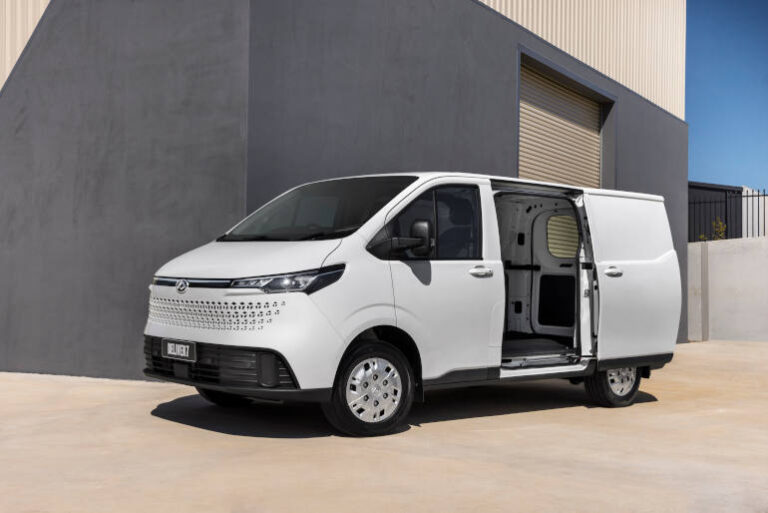LDV Australia has launched its new diesel-powered Deliver 7 midsize van, and it undercuts the already-launched eDeliver 7 electric van by a substantial amount.
The diesel-only Deliver 7 model range is slimmer than the eDeliver 7 line-up, and there are sweet deals for ABN holders for the diesel, too.
Here’s how the range of Deliver 7 diesel and eDeliver 7 EV models stacks up:
- Deliver 7 SWB low-roof – $42,490 drive-away (ABN)
- Deliver 7 LWB low-roof – $44,490 drive-away (ABN)
- eDeliver 7 SWB low-roof 77kWh – $59,990 plus on-roads
- eDeliver 7 LWB low-roof 77kWh – $61,990 plus on-roads
- eDeliver 7 LWB low-roof 88kWh – $64,990 plus on-roads
- eDeliver 7 LWB high-roof 88kWh – $66,990 plus on-roads
The pricing puts it at an advantage compared to big-name diesel van rivals such as the Toyota HiAce (from $48,886 plus on-roads), Renault Trafic (from $49,000 plus on-roads), VW Transporter (from $45,890 plus on-roads), Hyundai Staria Load (from $46,740 plus on-roads) and the Ford Transit Custom (from $56,590 plus on-roads).
Obviously you’ll need to do the maths about purchase and running costs in comparison to the eDeliver 7 – electric vans can be very cost-effective for business operators with back-to-base vehicles that can charge onsite overnight (off-peak!), but diesel has the advantage of being readily available across the entire country, and with a five-minute refill time rather than potentially sitting idle for hours to recharge.
The diesel models run a 2.0-litre four-cylinder turbo engine with 123kW of power and 390Nm of torque, which is more pulling power than any of the EVs have (150kW/330Nm). The diesel gets a nine-speed ZF auto and it’s front-wheel drive.
LDV claims an official combined cycle fuel consumption figure of 7.7 litres per 100km, and during my mainly unloaded test, I saw 8.4L/100km across a mix of roads and scenarios. It has an 80-litre fuel tank, and it runs a Euro 5 engine, so there’s no need to worry about AdBlue, either.
The drive experience is decent. It has a good amount of urge in the mid range, and not too much lag down low, either. The nine-speed auto is smart and smooth in most situations, and the steering is predictable and easy to manage, too. Just be mindful that the SWB has a notably better turning circle of 12.1m, while the LWB has a 13.4m turning circle.
The unladen ride is better than some rivals, but it can feel a bit bouncy under braking if you hit a bump. Not many vans out there will run around empty, though.
The cargo capacity is class-leading, according to LDV – here’s a table to make it nice and digestible:
| SWB Low Roof | LWB Low Roof | |
| Cargo area length | 2547mm | 2913mm |
| Cargo area height | 1328mm | |
| Cargo area width | 1800mm | |
| Width between arches | 1390mm | |
| Side door opening width | 990mm | |
| Side door opening height | 1200mm | |
| Rear doors width | 1425mm | |
| Rear doors height | 1242mm | |
| Total volume | 6.3m3 | 7.2m3 |
| Ground clearance | 147mm – laden | |
Worth noting here that the diesel model has a bit more total cargo volume due to a greater load height than the EV, which has its battery system built under the floor – and as well as that, the EV has a standard two-seat bench for passengers, where the diesel has a single seat (two-seat capacity total).
As such, the SWB eDeliver 7 has 5.9m3, and the low-roof LWB eDeliver 7 has 6.7m3 available. You can’t get the diesel with a high-roof, which in the EV model makes for a massive 8.7m3 of space.
And if you’re wondering about the size difference, here are the dimensions for the two diesel models:
- SWB Low Roof: 4998mm long, 2323mm wide, 1998mm tall, 3000mm wheelbase
- LWB Low Roof: 5364mm long, 2323mm wide, 1998mm tall, 3366mm wheelbase
Every version of the diesel van comes with a kerbside sliding door, and barn doors that open up to 180 degrees at the rear. There is an optional driver’s side sliding door, which is bundled into an accessory pack that also includes a surround-view camera system and 16-inch alloy wheels.
The interior is virtually identical to the electric model, with a 12.3-inch touchscreen media system that incorporates Android Auto and Apple CarPlay, but you have to plug in using a USB-A plug to use it. There’s also a 4.2-inch driver info screen which includes a digital speedometer, too.
Cabin comfort is fine, but the rubber flooring of the cargo area stinks, and it might take some time to get that smell out. Otherwise, it’s comfortable, there is an arm-rest for the driver, and good adjustment for the seat, too. Ample storage is a highlight, with multi-tiered doors and pockets aplenty, including an ash-tray, which is odd. No overhead folder holders, though.
The Deliver 7 gets all the same safety tech as the eDeliver 7, which achieved the ANCAP Gold Rating for crash-avoidance technology testing. Some of it is frustrating, like the speed sign warning system which beeps incessantly (and incorrectly at times), and the lane keeping tech and driver monitoring camera might be annoying for some drivers, too.
LDV backs the Deliver 7 with a seven-year, 200,000km warranty, and there’s five years of roadside assistance. Servicing is every 12 months or 20,000km after an initial 5000km check. There’s no capped-price maintenance plan, though.
On the whole, there’s a lot to appreciate about the diesel Deliver 7. It really does deliver on value, space and safety.






